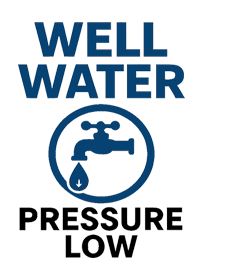A well pump is like the heart of your water system, pulsing life into the pipes that weave through your home. When it beats steadily, everything flows smoothly. But when that rhythm falters, and well water pressure low interrupts the flow, the heart of your system is struggling. Pressure loss that comes and goes is like a faint heartbeat—unpredictable, alarming, and disruptive.

Intermittent well pump pressure loss is a frustrating issue that leaves homeowners wondering: why does it seem to happen at random? Let’s explore the common causes behind this irregularity and the solutions that will restore the steady beat of your well system.
Common Causes of Intermittent Pressure Loss
1. Clogged or Dirty Pressure Switch
A pressure switch is the silent operator of your water system, like a traffic light directing the flow of water through the pipes. But over time, dirt, debris, or mineral deposits can clog the switch, causing it to malfunction intermittently. It may fail to trigger the pump properly, leading to well water pressure low at unpredictable times.

2. Air in the Pressure Tank
An air bladder inside your pressure tank serves as a buffer between the pump and your plumbing. When this air bladder becomes waterlogged, it can cause erratic water flow. Think of it as a balloon that loses its air—when squeezed, it releases a burst of air, creating an uneven flow. If the tank is improperly pressurized or the bladder is damaged, it can result in inconsistent water pressure.
3. Pump or Motor Failure
A pump that is on its last legs is like a tired athlete stumbling in the middle of a race. If the pump motor starts to fail or is not functioning optimally, it may intermittently struggle to keep the pressure up. This can lead to sudden and unpredictable drops in pressure, particularly if the pump overheats or is overworked.
4. Waterlogged Pressure Tank
A waterlogged pressure tank is a common culprit in cases of intermittent pressure loss. It’s like a sponge that’s too full to absorb any more water. If the air chamber inside the pressure tank is saturated with water, it cannot properly store and release pressure. This can lead to spikes and dips in water pressure, leaving you with frustrating bursts of well water pressure low.
5. Leaking Pipes or Connections
Leaks can be hard to find, especially if they’re in an obscure or hard-to-reach place. A small leak in the piping can cause pressure loss when the system is not actively in use. Think of it like air slowly leaking from a tire—eventually, the pressure will drop, and the system will struggle to maintain flow. The problem may occur intermittently, depending on when the system is cycling on or off.
Solutions for Intermittent Well Pump Pressure Loss
1. Clean or Replace the Pressure Switch
Cleaning the pressure switch is like clearing a blocked airway. It restores the flow and ensures the pump activates properly when needed. If cleaning doesn’t help, replacing the pressure switch is a simple fix to ensure the system functions smoothly. The switch should be cleaned and tested regularly to avoid future issues.
2. Adjust or Replace the Pressure Tank
The pressure tank plays a critical role in maintaining steady pressure. If your tank is waterlogged, draining it and recharging it with air may be enough to restore normal function. If the bladder inside the tank is damaged, you may need to replace the entire tank. A properly pressurized tank keeps the system steady, ensuring that water flows smoothly without those annoying dips in pressure.
3. Examine and Repair the Well Pump
Inspecting and maintaining the well pump is essential to maintaining reliable pressure. If the motor is showing signs of wear, it may need to be replaced. Regular servicing of the pump can help extend its life and improve its performance. Think of it as tuning up a car—taking care of the heart of the system ensures a longer, smoother ride.
4. Locate and Fix Leaks
Leaks should be identified and repaired promptly. Even small, intermittent leaks can have a significant impact on pressure. Inspecting the pipes and connections for signs of wear, corrosion, or leaks can help prevent future issues. Repairing these leaks is like fixing cracks in a dam—it restores the integrity of the system, ensuring the water can flow without interruption.
Objections & Answers
Objection 1: “Why is the pressure switch so easily clogged? Isn’t it supposed to be durable?”
Answer: The pressure switch can become clogged due to mineral buildup, dust, or even rust from the pipes. While it is durable, over time, the accumulation of particles can affect its operation. Regular cleaning is a simple solution to this problem, much like clearing dust from a fan to ensure it runs smoothly.
Objection 2: “Couldn’t the waterlogged pressure tank just be fixed by adding more air?”
Answer: If the air bladder is fully saturated with water, adding air won’t fix the problem. The bladder acts as a cushion, absorbing pressure. Once waterlogged, it loses this function, and the tank may need to be replaced. A quick air recharge might work temporarily, but it’s not a permanent solution if the tank itself is compromised.
Objection 3: “Why does my pump only fail intermittently? Shouldn’t it just break if it’s failing?”
Answer: A pump can show signs of failure intermittently due to overheating or fluctuating power supply. If the pump is overworked or the motor is beginning to wear out, it may function properly for a while, but as the system cycles on and off, it may struggle. Over time, these issues will worsen and become more frequent.
Objection 4: “Could my pipes really be leaking in multiple spots without me noticing?”
Answer: Yes, leaks can sometimes be small and hidden, making them difficult to spot. If the leaks are only present when the pump is on or cycling, it may take a trained eye to detect them. Regular inspections and maintenance are key to preventing these kinds of slow leaks from causing significant pressure loss.
The Rewards of Solving Intermittent Pressure Loss
Steady, Reliable Pressure – The frustration of fluctuating pressure becomes a thing of the past.
Longer Equipment Life – Regular maintenance and prompt repairs can prolong the life of your pump, tank, and system.
Consistent Water Flow – No more surprises when you turn on the tap.
Peace of Mind – Knowing that your system is functioning optimally brings lasting reassurance.
Restoring the Rhythm of Your Well Pump
Intermittent well pump pressure loss is like a dance that falters in the middle of the music. It’s frustrating, unpredictable, and disruptive. But with careful attention to the heart of your system—the pressure switch, tank, pump, and pipes—you can restore the flow, and once again, let the water pulse through your home with steady, reliable pressure.
